Wander Jager, Roel Popping and Hans van de Sande (2001)
Clustering and Fighting in Two-party Crowds: Simulating the Approach-avoidance Conflict
Journal of Artificial Societies and Social Simulation
vol. 4, no. 3,
To cite articles published in the Journal of Artificial Societies and Social Simulation, please reference the above information and include paragraph numbers if necessary
<https://www.jasss.org/4/3/7.html>
Received: 5-Feb-01
Accepted: 7-Jun-01
Published: 30-Jun-01
 Abstract
Abstract
![]() Introduction
Introduction
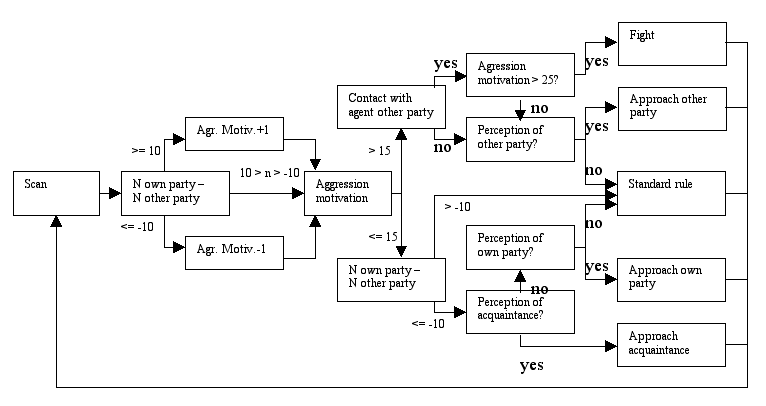
|
| Figure 1. The behavioural model of the agents |
.
| Table 1: Design of the study | ||||
| Large crowd (400) | Small crowd (100) | |||
| HC = 1% | HC = 5% | HC = 1% | HC = 5% | |
| Symmetrical | HC: 2/2 HO: 4/4 BY 194/194 | HC: 10/10 HO: 20/20 BY: 170/170 | HC: 1/1 HO: 2/2 BY: 47/47 | HC: 3/3 HO: 6/6 BY: 41/41 |
| Asymmetrical | HC: 1/3 HO: 2/6 BY: 97/291 | HC: 5/15 HO: 10/30 BY: 85/255 | HC: 0/0 HO: 0/1 BY: 25/74 | HC: _ HO: 2/7 BY: 22/64 |
| In the table the numbers of each type of agents for each party are given. HC = Hardcore, HO = Hanger-on; BY = Bystander | ||||
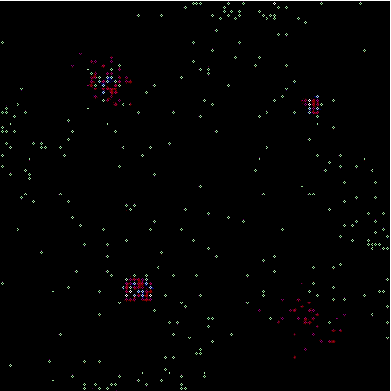
|
| Figure 2. An example of clustering |
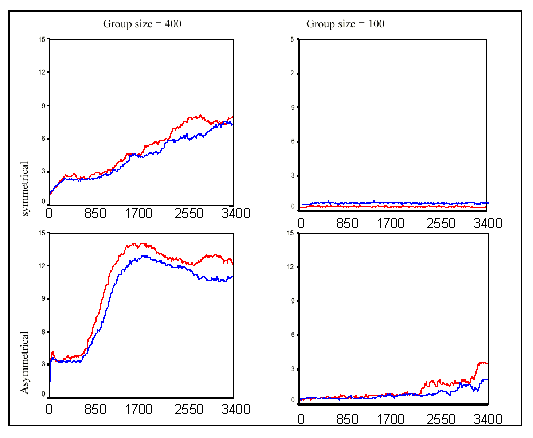
|
| Figure 3. Number of group members at a distance of 3 or less. The blue line denotes the conditions with 1% hard-core, the red line the conditions with 5% hard-core. Note the smaller scale of the y-axis scale in the top right figure for reasons of visibility. |
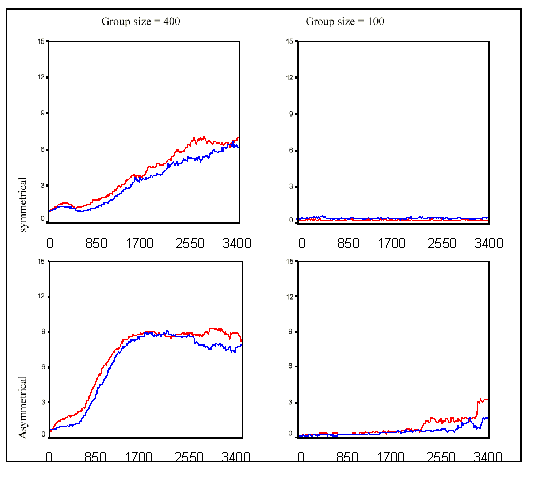
|
| Figure 4. Number of non-group members around up to distance 3. The blue line denotes the conditions with 1% hard-core, the red line the conditions with 5% hard-core. |
| Table 2: Percentage of agents involved in fight | |||||||||
| Large crowd (400) | Small crowd (100) | ||||||||
| HC=1% | HC=5% | HC=1% | HC=5% | ||||||
| Att. | Vict. | Att. | Vict. | Att. | Vict. | Att. | Vict. | ||
Symmetrical | All HC HO BY | 0.01 - - 0.01 | 0.01 - - 0.01 | 0.38 0.28 0.08 0.03 | 0.36 0.03 - 0.33 | - - - - | - - - - | - - - - | - - - - |
Asymmetrical | All HC HO BY | 88.74 4.84 4.94 78.99 | 66.70 1.01 2.65 63.04 | 132.3 26.10 29.44 76.76 | 96.99 6.37 8.92 81.71 | 0.10 - - 0.10 | 0.10 - - 0.10 | 7.62 1.68 2.42 3.52 | 6.76 0.02 - 6.74 |
| In the table the numbers of each type of agents for each party are given. HC = Hardcore, HO = Hangers-on, BY = By-standers; Att. = attacking agent, Vict. = victimised agent | |||||||||
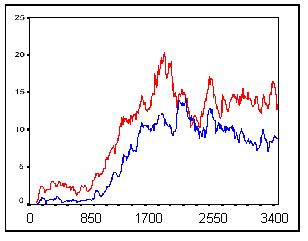
|
| Figure 5. Number of fights started over time for the N=400 asymmetric condition. The blue line denotes the conditions with 1% hard-core, the red line the conditions with 5% hard-core. |
ADANG, O., (1998). Hooligans, autonomen, agenten. Alphen aan den Rijn: Samsom.
AXELROD, R. (1997). Advancing the art of simulation in the social sciences. In: R. Conte, R. Hegselmann and P. Terna, (Eds.) Simulating Social Phenomena. Berlin: Springer.
BOUVIER, E., Cohen, E., Najman, L., (1997). 'From crowd simulation to airbag depolyment: particle systems, a new paradigm of simulation.' Journal of Electronic Imaging 6(1), pp. 94-107.
GRANOVETTER, M. (1978) 'Threshold models of collective behavior,' American Journal of Sociology 83 (6): 1420-1443.
HELBING, D. & VICSEK, T. (1999). Optimal Self-Organization. New Journal of Physics 1, 13.1-13.17.
HELBING, D. FARKAS, I. & VICSEK, T. (2000). Simulating dynamical features of escape panic. Nature, 407, 487-490 (2000).
HOGG, M.A. & ABRAMS, D. (1988) Social Identifications: A Social Psychology of intergroup Relations and Group Processes. London: Routledge.
JAGER, W. (2000). Modelling consumer behaviour. Doctoral thesis. Groningen: University of Groningen, Centre for Environmental and Traffic psychology.
JANSSEN, M.A. and DE VRIES, H.J.M. (1999), Global modelling: managing uncertainty, complexity and incomplete information, in: C. van Dijkum, D. de Tombe, E. van Kuijk, (Eds.). Validation of simulation models. Amsterdam: SISWO. pp. 25-69.
LEBON, G. (1952 [1896]) The Crowd. (Translation of: La Psychologie des Foules.) London: Ernest Benn.
MARX, G. & McADAM, D, (1994) Collective behavior and social movements. Englewood Cliffs, Prentice Hall.
McPHAIL, C. (1991) The Myth of the Madding Crowd. New York: Aldine de Gruyter.
MILGRAM, S. & TOCH, H. (1969) 'Collective behavior: Crowds and social movements,' in: Lindzey, G. & E. Aronson (eds.) Handbook of Socal Psychology Volume 4. Reading: Addison-Wesley, 507-610.
MILLER, N.E. (1944) 'Experimental studies of conflict' in: J.McV.Hunt(Ed.) Personality and the behavior disorders. New York: Ronald Press.
MUSSE, S.R., & THALMAN, D., (1997). A Model of Human Crowd Behaviour: Group Inter-relationship and Collision Detection Analysis. Computer Graphics Lab. Swiss Federal Institute of Technology. EPFL, DI- LIG, CH 1015 Lausanne, Switserland. <http://ligwww.epfl.ch/~soraia/Papers/CAS97/CAS97.crowd.doc.html>
REICHER, S. (1987) 'Crowd behaviour as social action,' in: Turner, J.C. (ed.) Rediscovering the Social Group. Oxford, Blackwell, 171-202.
REYNOLDS, C., (1987). 'Flocks, Herds and Schools: A Distributed Behavioral Model.' Proc. SIGGRAPH'87, Computer Graphics, 21, 4, July 1987.
SCHELLING, T.C., (1978). Micromotives and Macrobehaviour. New York: Norton & Company.
TU, X., & TERZOPOLOUS, D., (1994). 'Artificial Fishes: Physiscs, Locomotion, Perception, Behaviour.' Proc. SIGGRAPH'94, Computer Graphics, July 1994.
YIN, J.H., VELASTIN, S., DAVIES, A.C., (1994). Measurement of Crowd Density using Image Processing. VII European Signal Processing Conference, EUSIPCO-94, Edinburgh, UK, Sept.
Return to
Contents
of this issue
© Copyright Journal of Artificial Societies and Social Simulation, 2001